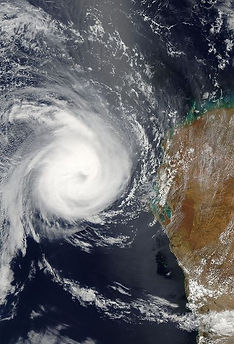
1.
What is the Cyclone?
A tropical cyclone is a rapidly rotating storm system characterized by a low-pressure center, a closed low-level atmospheric circulation, strong winds, and a spiral arrangement of thunderstorms that produce heavy rain and/or squalls. Originating over tropical or subtropical waters, these systems can lead to significant meteorological phenomena, including intense rainfall, high winds, and severe coastal and inland flooding. Depending on their location and strength, they are referred to by different names such as hurricanes, typhoons, or simply cyclones.
2.
Formation and Conditions
Tropical cyclones form over warm ocean waters near the equator. They require sea surface temperatures of at least 26°C (79°F), moist air, and relatively calm upper-level winds to develop. The warm ocean waters provide the energy needed for the storm, and the Earth's rotation helps it spin up.
.jpg)
3.
Structure
The structure of a tropical cyclone features several key components:
Eye: The center of the cyclone, characterized by light winds and clear skies.
Eyewall: Surrounding the eye, this area contains the highest winds and most intense rainfall.
Rainbands: These are dense bands of clouds that swirl around the eyewall, capable of producing heavy bursts of rain and wind.

4.
Categories
Tropical cyclones are classified into categories based on their wind speeds and potential for damage. The Saffir-Simpson Hurricane Wind Scale is a 1 to 5 rating based on the cyclone's maximum sustained wind speed. This scale estimates potential property damage.

5.
Path and Movement
The movement of tropical cyclones is influenced primarily by the global winds and surrounding atmospheric pressures. These paths can be unpredictable, making it difficult to predict the storm’s exact location and intensity far in advance.


6.
Impact
The impact of tropical cyclones can be devastating. High winds, heavy rainfall, and storm surge (rise in seawater level caused primarily by the storm's winds pushing water onshore) are the main hazards associated with a cyclone.